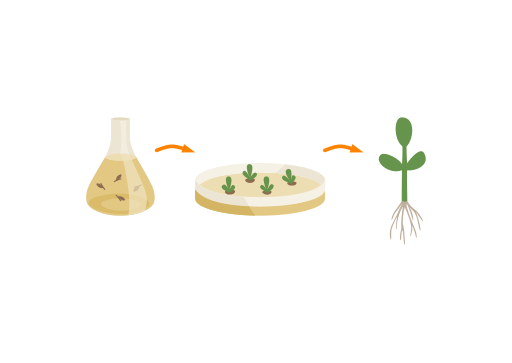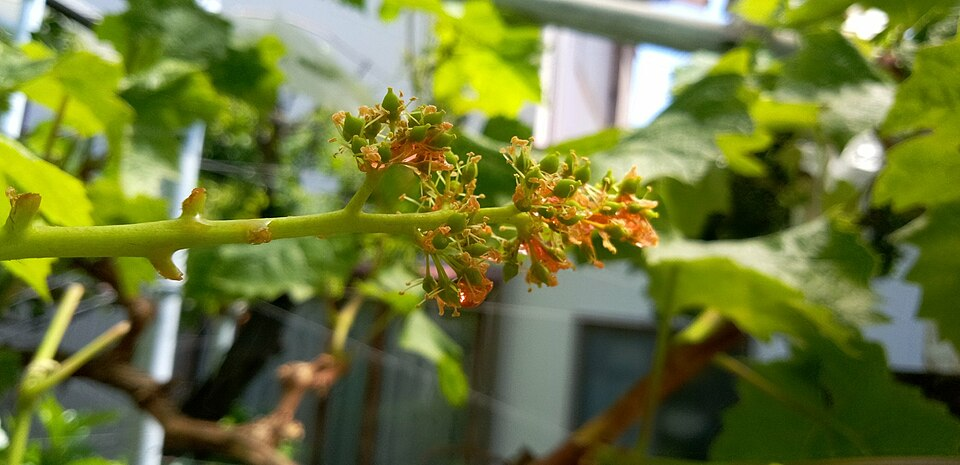OCR Specification focus:
‘Describe commercial applications: controlling ripening, using rooting powders, and applying hormonal weed killers.’
Plant hormones play vital roles in agriculture and horticulture. Understanding how auxins, gibberellins, ethene, and other hormones are exploited allows humans to manipulate plant growth and development for economic and environmental benefit.
Hormones in Commercial Plant Management
The Role of Plant Hormones
Plant hormones, also known as plant growth regulators, are chemical messengers that influence cell growth, division, differentiation, and organ development. By applying these hormones synthetically, humans can control growth patterns, enhance yield, and improve storage or transport characteristics of crops.
Auxins in Commercial Use
Rooting Powders
Auxins, particularly indole-3-acetic acid (IAA) and synthetic analogues such as indole-3-butyric acid (IBA) and naphthaleneacetic acid (NAA), are used to stimulate root growth in cuttings.
Auxin: A plant hormone that promotes cell elongation, apical dominance, and root initiation.
When plant cuttings are dipped into rooting powder containing auxin, root initiation is stimulated in the stem base, increasing the likelihood of successful propagation. This technique is crucial for commercial production of plants that do not easily produce roots naturally, such as woody ornamentals and fruit trees.
Key points:
Auxin increases cell wall plasticity, allowing elongation of root cells.
Synthetic auxins are preferred because they are more stable and cost-effective than natural IAA.
Optimal auxin concentration is critical — excess levels inhibit root growth.
Tissue Culture and Micropropagation
Auxins also work synergistically with cytokinins in tissue culture. The auxin:cytokinin ratio determines organ formation:
High auxin, low cytokinin → root formation
Low auxin, high cytokinin → shoot formation
This manipulation allows rapid cloning of genetically identical plants.

A simplified workflow of plant tissue culture from explant to regenerated plant. Commercial labs adjust the auxin:cytokinin ratio to induce roots or shoots for rapid micropropagation of elite cultivars. The diagram includes general steps beyond the OCR syllabus but remains directly relevant to commercial hormone use. Source.
Auxins as Weed Killers (Herbicides)
Synthetic auxins, such as 2,4-dichlorophenoxyacetic acid (2,4-D) and 2,4,5-trichlorophenoxyacetic acid (2,4,5-T), are used as selective herbicides. They are particularly effective against dicotyledonous (broad-leaved) weeds while leaving monocotyledonous (grassy) crops such as wheat and maize unharmed.
Mechanism of action:
Mimic natural auxin but are non-biodegradable and persist longer.
Cause uncontrolled cell division and elongation in susceptible plants.
Lead to distorted growth, nutrient depletion, and plant death.
This selectivity allows efficient weed control in cereal fields and lawns.
However, misuse or high doses can damage non-target plants and ecosystems, so environmental regulation governs herbicide application.
Gibberellins in Agriculture
Controlling Stem Elongation and Growth
Gibberellins are used to promote stem elongation in dwarf varieties of plants, such as sugarcane, by stimulating cell division and elongation in internodes. This leads to greater biomass and sugar yield per plant.
Gibberellin: A plant hormone that promotes stem elongation, seed germination, and fruit development by stimulating cell elongation and enzyme synthesis.
Fruit Development
Gibberellins can induce seedless fruit (parthenocarpy) in species like grapes, enhancing size and commercial value. They also delay senescence, improving shelf life during transport.

Gibberellin treatment produces longer, better-spaced grape bunches suitable for premium table-grape markets. Applications at defined stages promote elongation and reduce compactness, improving appearance and reducing post-harvest losses. The image also implies effects on berry spacing, which aligns with commercial GA₃ use. Source.
Brewing and Malt Production
Gibberellins are used to trigger amylase enzyme synthesis in barley seeds during malting. This converts stored starch into maltose, an essential sugar for brewing.
Commercial advantages:
More consistent malting process.
Controlled timing for large-scale beer production.
Ethene and Control of Fruit Ripening
Regulating Ripening in Storage and Transport
Ethene (C₂H₄) is a gaseous plant hormone that stimulates fruit ripening by promoting enzyme activity involved in softening and colour change.
Ethene: A gaseous plant hormone that accelerates fruit ripening, flower opening, and leaf abscission.
Commercially, ethene or ethylene-releasing compounds (such as ethephon) are used to control ripening schedules.
Practical applications:
Bananas and tomatoes are harvested green and firm to prevent damage during transport.
Exposure to ethene in storage triggers uniform ripening just before sale.
Controlled atmosphere storage (reducing ethene concentration and oxygen) slows ripening, extending storage time.

Bananas in multiple ripeness stages demonstrate how ethene accelerates the transition from green to sale-ready yellow. Commercial systems expose stored fruit to controlled ethene to achieve uniform ripening on demand. This visual aligns with the practice of harvesting firm, green fruit for transport and ripening near market. Source.
Synchronising Flowering and Harvest
Ethene also promotes flower induction in some species (e.g., pineapples), allowing uniform fruiting for efficient mechanical harvesting.
Cytokinins in Commercial Production
Though not explicitly required by the OCR specification for this subsubtopic, cytokinins are often used alongside auxins in horticulture. They delay leaf senescence, promote bud formation, and increase post-harvest freshness in cut flowers and vegetables.
Example uses:
Spraying cytokinins on lettuce or broccoli maintains green pigmentation.
Extends shelf life, reducing food waste and increasing profitability.
Integration of Hormonal Applications
Combining Hormonal Effects
Commercial plant production often involves integrated use of several hormones to achieve specific goals:
Auxins and gibberellins may be combined to improve fruit set.
Ethene and gibberellins coordinate fruit ripening and growth.
Adjusting hormone ratios allows precise control over development stages.
Economic and Ethical Considerations
Hormonal applications enhance yield and reduce losses, but must be managed responsibly. Overuse can:
Disrupt ecosystems through runoff or residue accumulation.
Influence consumer perception of ‘natural’ food production.
Lead to resistance in target weeds if herbicides are misused.
Regulatory frameworks such as EU pesticide directives and the UK Chemicals Regulation Division ensure safe application and environmental monitoring.
Summary of Key Commercial Roles
Auxins:
Rooting powders for propagation.
Selective weed killers in agriculture.
Organogenesis in tissue culture.
Gibberellins:
Stem elongation in dwarf crops.
Induction of seedless fruit.
Enzyme activation in brewing.
Ethene:
Controlled fruit ripening and storage management.
Synchronised flowering and harvesting.
These hormonal applications represent powerful tools in modern agriculture, allowing efficient, predictable, and profitable plant production aligned with the OCR A-Level Biology syllabus.
FAQ
Ethene levels are carefully regulated using controlled atmosphere storage (CAS) systems. These systems monitor and adjust gas composition to slow ripening.
Low oxygen (2–5%) and high carbon dioxide (up to 5%) reduce ethene production and sensitivity.
Ethene scrubbers or absorbers (e.g. potassium permanganate filters) remove excess gas.
Temperature and humidity are optimised to delay metabolic activity and extend storage life.
This control enables growers to coordinate supply with market demand without reducing fruit quality.
Gibberellin-treated seedless grapes are larger, more uniform, and have thinner skins, making them ideal for the fresh fruit market.
Consumers prefer seedless varieties for convenience.
Gibberellins promote cell elongation and loosen berry clusters, improving airflow and reducing fungal infections.
The resulting bunches have a more appealing shape, making packaging and transport easier.
These factors increase both market value and shelf life of table grapes.
The ratio determines whether new tissues develop into roots, shoots, or callus.
High auxin : low cytokinin → root formation.
Low auxin : high cytokinin → shoot formation.
Equal concentrations → undifferentiated callus growth.
By adjusting this balance, horticulturists can clone plants quickly and generate identical stock for commercial propagation.
Overuse of synthetic auxin herbicides can lead to environmental pollution and non-target damage.
Drift during spraying may harm hedgerow plants or wildflowers.
Persistence in soil can reduce biodiversity and contaminate waterways.
Improper disposal of residues risks harming beneficial organisms such as pollinators or soil microbes.
Careful dosage control, buffer zones, and adherence to regulatory safety limits reduce these impacts.
Plant hormones act only during specific developmental windows.
Applying gibberellins too early can cause excessive vegetative growth instead of fruit development.
Late application may fail to affect fruit set or elongation.
Ethene exposure before maturity can soften fruit prematurely, reducing marketable quality.
Growers follow precise growth-stage schedules to ensure hormones trigger the intended physiological response for optimal yield and quality.
Practice Questions
Question 1 (2 marks)
Explain how synthetic auxins are used commercially as selective weed killers.
Mark scheme:
• Synthetic auxins mimic natural auxins but are not broken down as easily (1)
• They cause uncontrolled growth in dicotyledonous weeds, leading to death, while monocotyledonous crops remain unaffected (1)
Question 2 (5 marks)
Describe and explain three different commercial uses of plant hormones in agriculture or horticulture.
Mark scheme:
• Use of auxins in rooting powders to stimulate root growth in cuttings (1)
– Auxin promotes cell elongation and root initiation in stem bases (1)
• Use of gibberellins to promote fruit growth or produce seedless fruit such as grapes (1)
– Gibberellins stimulate cell division and elongation, increasing fruit size (1)
• Use of ethene to control ripening of fruit during storage and transport (1)
– Ethene triggers enzyme activity involved in softening and colour change, allowing synchronised ripening (1)
(Any three appropriate uses with correct explanations; maximum 5 marks)

